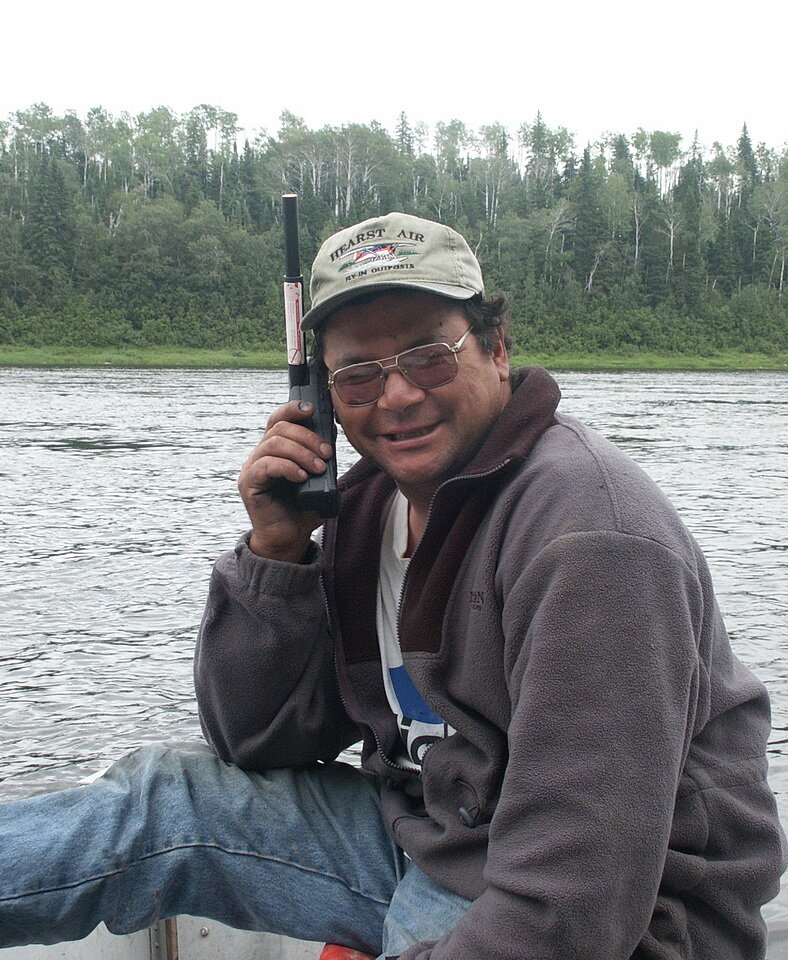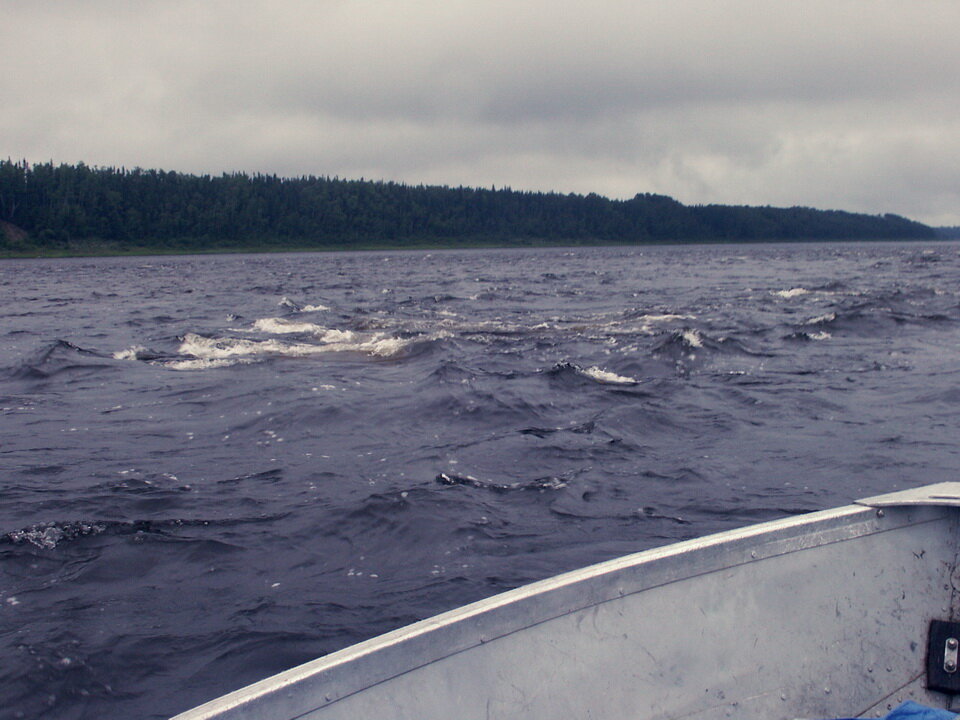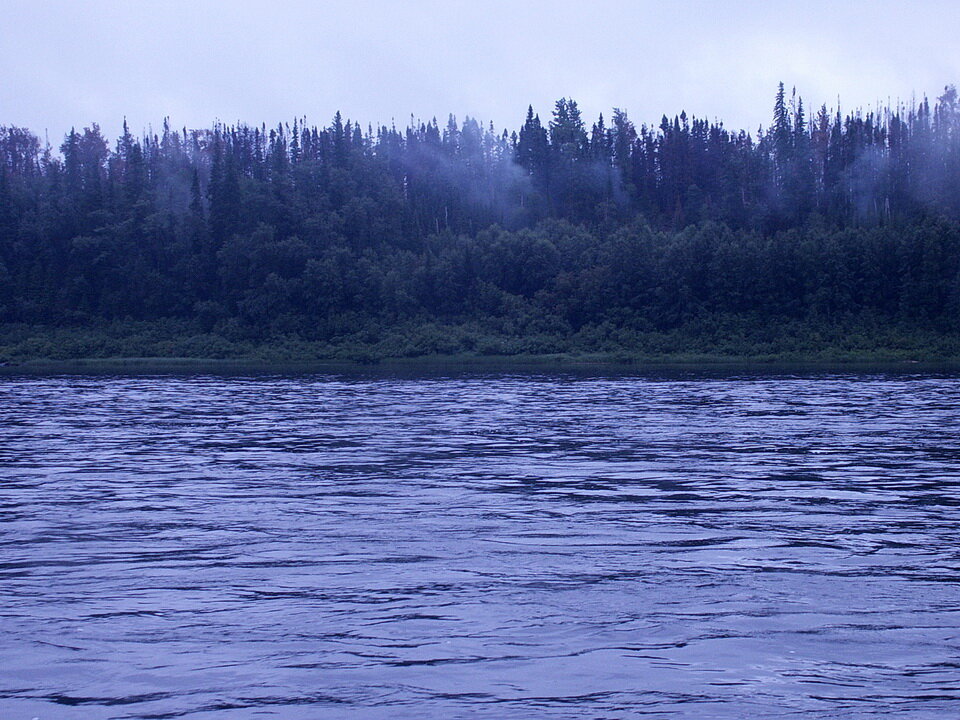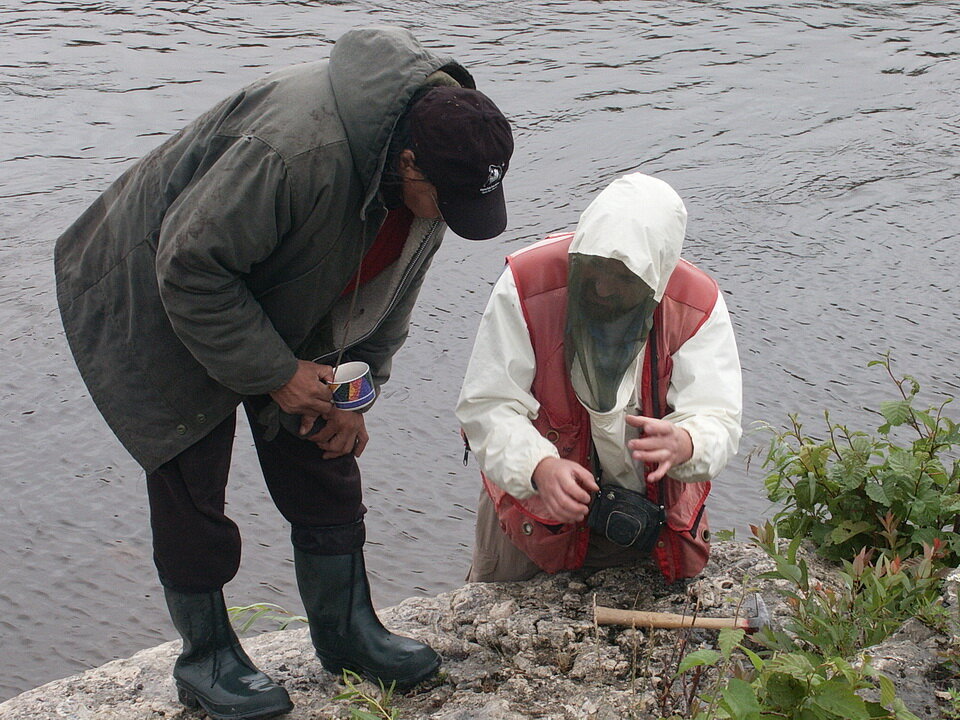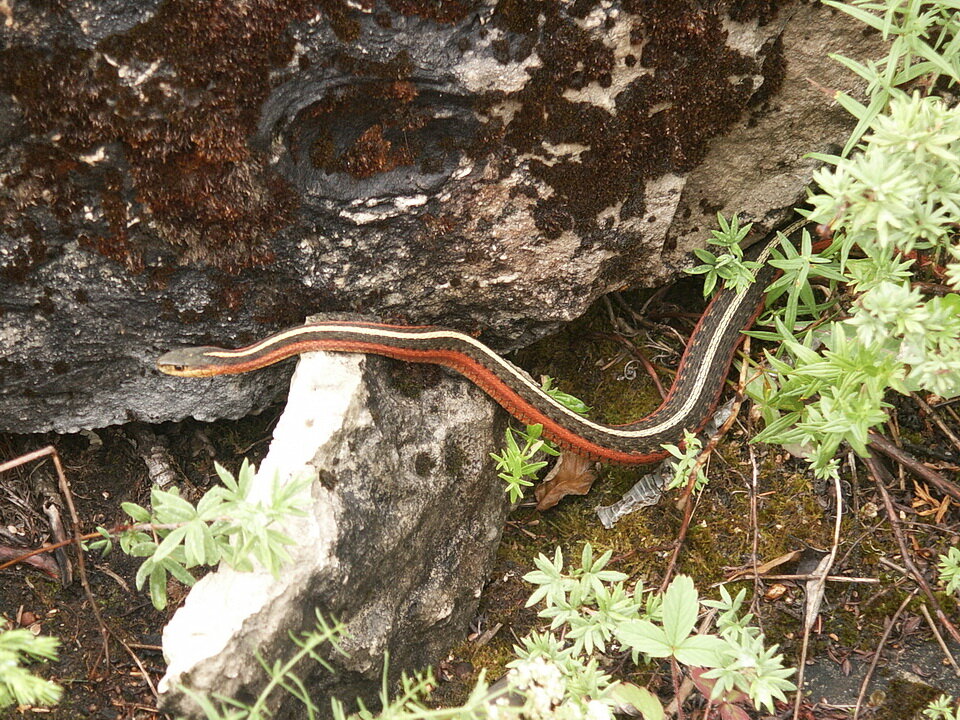Far North Rambles #22: I Hate Snakes
Well, “hate” is a strong word. Perhaps I should say I am not fond of snakes. I did not often see snakes when working in the bush, but when I did, my reaction was to jump.
Back in summer 2002, we had a fabulous trip down the Albany River with Chief Eli Moonias (Photo 1) and Norm Baxter (Photo 2), Marten Falls First Nation.
Photo 1: Chief Eli Moonias (Marten Falls First Nation) navigating down the Albany River, July 26/02. Image by Lori Churchill (Ontario Geological Survey at the time).
Photo 2: Norm Baxter (Marten Falls First Nation) on the satellite phone to order a part for his motor, on the Albany River, July 26/02. Image by Andy Fyon.
During an open house geology event with Marten Falls First Nation, Chief Eli mentioned the presence of dinosaur teeth, in a rock, located about 1-2 hours down the Albany River. Now, that would be interesting for several reasons. We had never been down the Albany River and that would be an adventure. Also, dinosaur fossils should not occur in the rocks along the Albany River. It was a mystery and an adventure! Lori Churchill, Derek Armstrong, and I, from Ontario Geological Survey, jumped at the opportunity to go the area with Chief Eli and Norm Baxter.
The next day was wet and rainy, but, after some discussion, we were on our way down the river. Chief Eli and Norm Baxter showed their extraordinary knowledge of the river. They read the waters and navigated left and right abruptly, but deliberately, to avoid shifting rock bars (Photo 3).
Photo 3: Skilled navigation by Chief Eli Moonias and Norm Baxter enabled safe passage down the Albany River, Ontario. Image by Andy Fyon, July 26, 2002.
We boated past a smouldering forest fire (Photo 4), and arrived safely at the rock area in the middle of the Albany River.
Photo 4: A smouldering forest fire along the Albany River, Ontario, July 26, 2002. There had been recent rain and that helped suppress the fire. Photo by Andy Fyon.
Derek Armstrong, of the Ontario Geological Survey, was a fossil expert. He excitedly described the story he read in the rocks (Photo 5). The preserved fossils represented the remains of many different, ancient, marine animals. They lived in a warm, subtropical ocean that covered this part of Ontario about 450 million years ago. It was an area teaming with life, with lots of food and plenty of sunlight. Geologically, it was a “happy, positive, energized” site that was millions of years old.
Photo 5: Left Chief Eli Moonias (Marten Falls First Nation) and right Derek Armstrong (Ontario Geological Survey, fossil expert) discussing the story in the rock. Albany River, July 26, 2002. Image by Andy Fyon.
Because it was cold and rainy, and because it was culturally appropriate, we enjoyed a tea break on rocky side of the Albany River (Photo 6). Norm built a fire and prepared the tea while Chief, Lori, Derek and I discussed the rock and the dinosaur teeth.
Photo 6: Tea time along the Albany River on a wet day. Left to right: Norm Baxter (Marten Falls First Nation, Lori Churchill (Ontario Geological Survey at the time), Chief Eli Moonias (Marten Falls First Nation. Image by Andy Fyon, July 26, 2002.
There was one last area to explore - behind the big rock. I wandered over to “have a little walk” and look at the geology and the wildflowers. Suddenly, it felt like the whole ground was moving - snakes! Lots of them! Red-sided garter snakes (Photo 7)!
Photo 7: The area on the side of the rock was home to many red-sided, Eastern Garter Snakes (Thamnophis sirtalis ssp. sirtalis). This rock is called Flat Rock and is located along the south side of the Albany River, Ontario. I am not fond of snakes so it was a bit of a surprise to see so many snakes. This type of rock is an excellent area for snakes because there are many cracks and small interconnected cavities in the rock that provide excellent habitat for snakes. Image by Andy Fyon, July 26, 2002.
I felt like Indiana Jones in the snake pit! Not my happy place. As fast as I could, I retreated to the fire, trying to look “normal”, but I guess my face revealed my fear. We laughed and chatted about the snakes. I learned that Chief was also not fond of snakes! There are other parts of the visit that I will not describe in detail, including positive energy sites and little brown people.
I did learn how fast news travels in the north. The next day, we arrived back at the Nakina airport, we met some First Nation ladies in the airport who already knew where we had been. They asked if we had seen “anything else”, which was code for experiences that I won’t share.
I frequently shared this river navigation experience with my technical staff to illustrate why working together made really good operational sense. In the absence of Chief Eli and Norm, we would have lasted about 10 minutes on the river before destroying our boats and motors. We would not have learned of the fossils and their significance. Chief Eli and Norm had important geological, ecological, and cultural insights. Without their willingness to share, a big gap would have remained in our understanding of the area and its significance to the First Nation people.
Sadly, the world has changed and so have the lives of Chief Eli and Norm Baxter, but we remain grateful for that day with you. Miigwetch Ogima Eli and “number 1 guide” Norm Baxter. Shared with respect.
Andy Fyon, Sept 27, 2020 (Facebook, June 26, 2020); Jan 6/23


